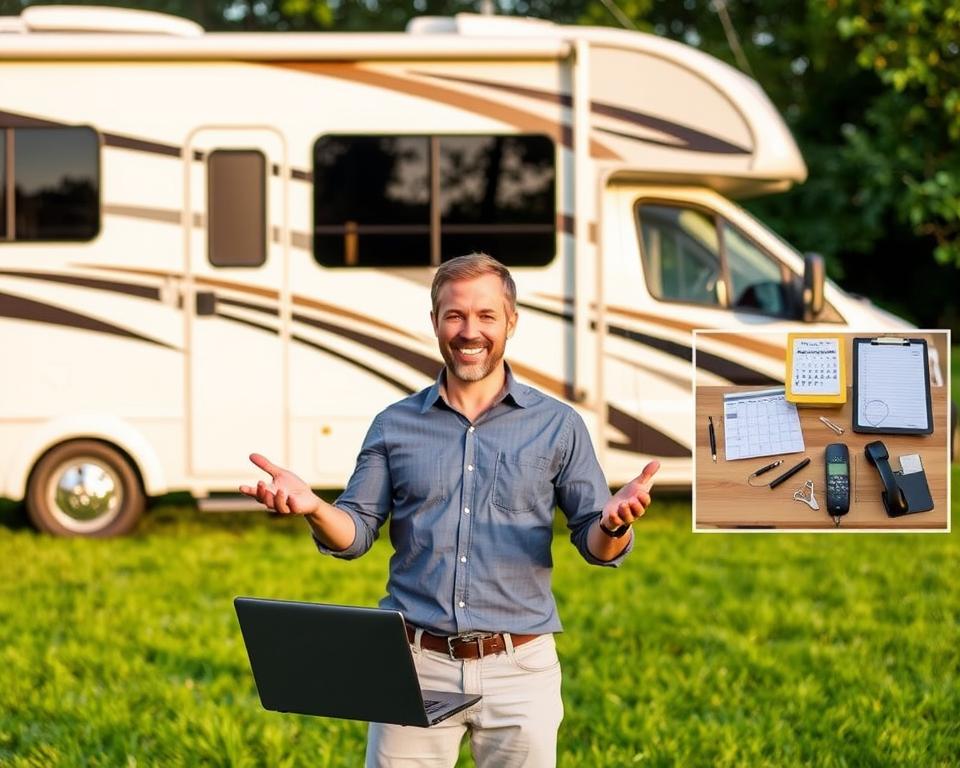RV Wastewater Pump Guide: Crucial Care Guidelines
Ever considered the mechanics of your recreational vehicle sewage network? Being aware of the details of your RV sewer pump can avert mishaps, enriching your camping trips. It’s centered on managing waste efficiently and dodging bad odors. With this manual, you’ll discover vital maintenance methods for RV sewage pump. Each strategy is intended to maintain your sewage system’s optimal function.
Grasping Your Recreational Vehicle Sewage Pump Setup
The camper sewage pumping setup is vital for refuse disposal, making camp trips more convenient. It features two principal tanks: the black-water reservoir for bowel output and the grey-water reservoir for water from wash stations. Differentiating these tanks is crucial to ward off clogs and keep your RV operating smoothly.
An RV waste grinder is a widely used solution for refuse disposal. It pulverizes solid waste into fine pieces, facilitating disposal. Alternatively, a standard waste pump is available. It competently moves waste without shredding, for those preferring a simpler option.
Knowing your RV’s sewage pumping system is key to warding off problems and ensuring clean inspections. Managing the system efficiently can prevent messes, improving your outdoor adventures.
Importance of Regular Maintenance
Upkeeping your RV sewer pump is essential for a seamless trip. Without proper servicing, you may encounter odors, clogs, or backups. These complications can wreck your road trips.
Routine checkups prevent such issues and sustain your system’s life. By examining hoses and seals, you improve efficiency. A properly cared-for RV sewage pump guarantees effective refuse removal, letting you enjoy seamless excursions.
Regular servicing also leads to financial savings over time. Neglect can cause significant problems, requiring expensive replacements. Putting resources into regular maintenance keeps your motorhome in top condition, conserving money long term.
How Frequently to Service Your RV Septic Tank?
Determining the proper interval to service your RV Septic tank is essential for its upkeep. It’s suggested to pump every 72–120 hours during use. For short trips, post-trip emptying may do the trick.
Interval depends on different variables. Tank capacity and usage level are critical. Preferably pump when it reaches 66% capacity. This helps support smooth flow and stop backups.
Checking your RV Septic tank levels is vital for a stress-free outing. Ensure proper management of your camper’s effluent to stop issues while traveling.

Recommended Tank Emptying Tips
Correctly draining RV tanks is crucial for your motorhome’s cleanliness and reliability. Start with the black water tank to let the grey water rinse leftover solids. This technique stops clogs and ensures efficient drainage.
Pick a high-quality drain hose for disposal. A reliable hose prevents leaks and locks connections. Add a tank rinser for a thorough rinse, using water pressure to remove residual sludge, boosting cleanliness.
Full discharge prevents residue buildup, stopping foul odors and potential issues. To maintain an optimal sewage system in your motorhome, implement these guidelines:
- Regularly use a tank treatment to keep odors at bay and break down waste.
- Keep an eye on fill levels to avoid overflows.
- Inspect your RV waste pump regularly for clogs and wear.
- Deep rinse tanks each month or twice monthly, even during less frequent trips.
Following these methods enhances your sewage system’s longevity and efficiency, ensuring smooth journeys.
Stopping Stench and Obstructions
For a pleasant camping experience, preventing foul aromas is crucial. Keep enough water in tanks to aid in waste breakdown, warding off unpleasant odors. Also, choosing camper-safe TP helps prevent clogs, avoiding backups.
For enhanced refuse control in campers, try bio-agent additives. These effectively break down waste, easing upkeep. Check the vent line often to keep air moving freely in the plumbing system.
Cautious flushing is crucial to avoiding tank issues. Avoid flushing wipes, feminine products, and paper towels. These non-compostable materials can cause serious blockages. Following these tips helps maintain a cleaner camping environment.
RV Sewer Pump Maintenance Tips
Maintaining your RV’s sewer pump system is vital for smooth journeys. Inspect dump valve seals regularly to avoid drips. Worn seals can cause surprise messes, harming your RV.
To eradicate odors and maintain cleanliness, sanitizing is essential. Do thorough sanitation regularly to prevent buildup, ensuring the system performs reliably. These steps are critical for maintaining a portable RV pump, promoting durability and efficient operation.
Oiling valve mechanisms is another crucial task. It helps prevent leaks and boost functionality. Monitoring tank sensors is critical for exact data, preventing spillovers and unexpected pump issues. Staying on top of these checks makes your RV adventures cleaner and more enjoyable.
Signs You Might Need a Professional Pump-Out
Spotting sewage issues early can ward off major issues. A primary clue you need a expert emptying is slow draining. When sinks and toilets take longer to clear, it often points to obstructions. It suggests your system may be jammed.
Ongoing foul scents are another obvious clue of sewage troubles. Unpleasant fumes hanging around despite cleaning suggest trapped waste. It’s crucial to inspect the clear elbow attachment when dumping waste. Remaining waste visibility signals it’s time for pro maintenance.
Technicians utilize jet machines to break up hard obstructions efficiently. Ignoring these warnings can lead to major problems. Therefore, it’s imperative to seek help immediately when issues arise.
| Warning Signs of Waste Problems | Suggested Steps |
|---|---|
| Delayed Drainage | Inspect for clogs; arrange professional pump-out |
| Persistent Odors | Examine system; book professional RV pump-out |
| Remaining Sludge | Call pro for deep cleanse |
Choosing the Right RV Macerator Pump
When choosing an RV macerator pump, weigh its capacity, build quality, and compatibility with your RV’s size. A reliable macerator is critical for efficiently breaking down waste. This is especially vital for RVs requiring regular emptying. High-end pumps optimize sewage handling, ensuring a problem-free adventure.
Various units cater to diverse needs. For an educated choice, focus on these key factors:
- Capacity: Confirm volume capability suits your needs.
- Durability: Opt for models built to endure travel demands.
- Ease of Use: Prefer straightforward, easy-to-use models.
- Compatibility: Confirm it matches your fittings.
Taking time to compare when choosing an RV macerator pump boosts travel enjoyment and ensures proper sewage disposal.
RV Sewer Pump Problem-Solving
Accurate diagnosis for your RV sewer pump is key in resolving common sewage issues before they worsen. If you notice sluggish emptying, unplanned backflows, or persistent odors, respond swiftly. These are definite clues of malfunction requiring attention.
Start with checking the pump, its connections, and hoses. Check for any clogs that could slow flow. Ensure inlet and outlet fittings are properly connected. Also, verify the pump’s power supply for reliable current.
If basic checks don’t uncover the issue, listen to the pump’s sound. A unit that’s abnormally loud or too quiet may have internal damage. Also, inspect for leaks, as these can worsen sewage problems. With these troubleshooting steps, many RV owners identify and fix issues early, avoiding costly repairs.
Long-Term RV Sewer Pump Care
For extended service life, commit to regular sewer pump upkeep. Sanitize the system consistently to prevent clogs. Establish and follow a maintenance routine, keeping everyone informed of their roles. This significantly improves your waste system’s lifespan.
Educating yourself and others on proper waste disposal is vital. This forestalls issues and fosters shared responsibility. The result benefits both users and the sewer system.
- Routine inspection of hoses and connections
- Maintain clear filter screens
- Arrange yearly pro maintenance
- Select suitable additives
Abiding by these practices boosts your camper’s sewage system’s durability and keeps it in top form, making travels more comfortable.
In Closing
Caring for your RV sewer system diligently is vital for seamless camping adventures. Regular attention to RV sewer system maintenance drastically lowers problem risks, letting you focus in the journey. By understanding your system and applying reliable sewage methods, your trips will be free of waste management woes.
Implementing the essential tips from this guide enhances RV waste management and improves your travel comfort and safety. Keep your sewer pump in top shape by following best upkeep practices and fixing potential issues promptly.
Staying vigilant about your RV sewer system yields benefits. It provides homely comforts while exploring. Wishing you joyous and carefree journeys!
Frequently Asked Questions
How do I know when it’s time to pump my RV Septic tank?
Service the tank at two-thirds fullness to optimize flow.
How do black and grey tanks differ?
Black tank is for sewage waste. Whereas, the grey tank collects water from sinks and showers.
When to service my RV sewer pump?
Check seals, sanitize, and clean quarterly.
Recommended products for RV sewer pump maintenance?
Opt for biological tank additives.
What prevents blockages in RV plumbing?
Avoid flushing non-biodegradable items.
How to know if I need expert pump-out?
Watch for slow drainage, recurring odors, or visible residue in the elbow.
How can I improve my RV macerator pump’s efficiency?
Ensure capacity and compatibility.
What should I check during a deep clean of my RV sewer system?
Inspect all connections and hoses.
What long-term care tips help my RV sewer pump?
Train users on proper disposal.
Septic pumping frequency for heavy RV use?
Schedule pump-outs every 3–5 days.


